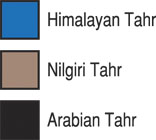 |
 |
Hemitragus hylocrius
Tar de Nilgiri (Sp), Nilgiri Tahr (G), Tahr de Nilgiri (F). Specific name is from the Greek hule (forest or woods) and krios (ram). At one time was incorrectly called Nilgiri ibex by hunters in southern India.
DESCRIPTION Shoulder height 39-42 inches (99-107 cm). Females are smaller than males, measuring up to 35 inches (89 cm) at the shoulder. Chromosome number is 58.
Slightly larger than the Himalayan tahr, and distinguished from it by its short, stiff coat, close-set horns, and only one pair of teats in the female. There is no ruff. The general color is dark yellowish-brown with a dark dorsal streak and pale underparts. Old males are darker, with a black face and a conspicuous grizzled white patch on the back behind the ribs, from which they have acquired the name "saddleback." Females and juveniles are grayer than males. The horns (both sexes) nearly touch at their bases, rise almost parallel, then turn backward and spread slightly. The outer surface is convex, the inner flat. Horns longer than 17 inches (43 cm) are reported from colonial times, but such were rare. The record is 17-1/2 inches (43.8 cm) (Rowland Ward, 1902). Stockley wrote in 1928 that anything over 14 inches (36 cm) was a good head. Females have slimmer and slightly shorter horns than males.
BEHAVIOR Gregarious, associating in herds of 10-30, and sometimes as many as 100. Adult males are usually in small groups, but may be alone or with the herds; however, the old saddlebacks are rarely with the herds. Breeding appears to take place throughout cold weather, with births (normally one young) seemingly at any time of year.
Active intermittently from dawn to dark. Mainly a grazer. Spends most of its time in much gentler terrain than the Himalayan tahr, but needs nearby difficult ground for refuge, and is perfectly at home on it. Leopards are said to be the chief predator.
HABITAT Grass-covered hills at altitudes of 4,000-6,000 feet (1,200-1,800 m), with refuge cliffs nearby.
DISTRIBUTION Southern India, from the Nilgiri Hills to the Anamalai Hills and southward along the Western Ghats.
STATUS Its range has declined through habitat destruction and its numbers have been reduced by poaching. Population was estimated at a little more than 2,200 in 1978.
|





